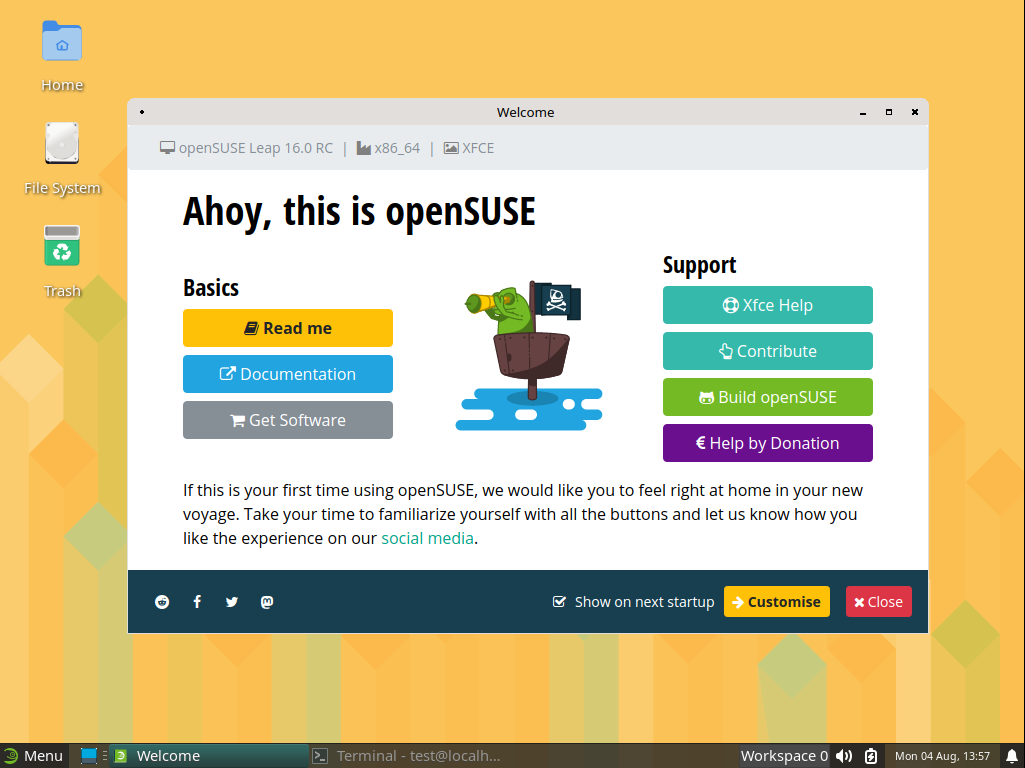#linux
#linux
[ follow ]
#open-source #ubuntu #ram #command-line #kde-plasma #flatpak #performance #backups #privacy #cybersecurity #gui-tools
fromZDNET
1 week agoThe new Debian Libre Live is all about free software, but I need my proprietary apps
In 2022, Debian developers decided to include some much-needed but non-free firmware to enhance their distribution's compatibility with a wider range of hardware. There were several reasons for this, including the state of open-source firmware for Nvidia GPUs. Given the importance of graphics devices in relation to AI, having firmware and drivers that are fully capable can mean the difference between them working properly and not.
Software development
fromZDNET
3 weeks agoLinux Mint vs. Zorin OS: I compared the two Windows alternatives, and here's my advice
Zorin OS experienced a significant increase in downloads following the release of Windows 10. Within a two-day stretch, Zorin OS had over 100,000 downloads, which was a record for the distribution.
Digital life
fromfaun.pub
1 month agoLinux permissions explained
Linux enforces a powerful permission model designed for multi-user security, access isolation, and resource governance. Whether you are an SRE, DevOps engineer, or a systems programmer, mastering Linux permissions is fundamental for secure and reliable operations. In this deep dive, we'll break down the basic permission system with practical examples. Permission Types in Linux Linux defines three access types: read:
Information security
fromZDNET
1 month agoMy favorite 2 tools for reading Linux manual pages the easy way
A man page is a manual page dedicated to a specific command, and every Linux distribution includes them. Man pages are a great way to get an in-depth look at how a command works. Say, for example, you wanted to learn about the chmod command. You could either run a Google search (and risk being inundated with AI slop) or read the man page.
Software development
Information security
fromZDNET
1 month agoMy top 5 password managers for Linux - and my favorite works on Windows and MacOS too
Use a password manager on Linux; multiple open-source, feature-rich options like Bitwarden and Buttercup provide strong security, cross-platform support, and self-hosting choices.
fromZDNET
1 month agoNeed to record your screen? 5 ways to do it on your Linux PC - for free
Desktop screen recordings are a way of life for some. Perhaps you're a PC support specialist, or you enjoy bragging about your highly configured desktop environment, or you offer tutorials for gaming or other purposes. Whatever the need, you're going to want to have a piece of software that makes grabbing those screen recordings easy. Your desktop of choice might include a tool for taking screenshots and even screen recordings, but that might not be flexible enough for you.
Gadgets
fromZDNET
1 month ago5 ways the Linux nmap command can help keep your network secure
The nmap command (short for network mapper) is a network exploration/security auditing tool that can rapidly scan networks to help you find out what hosts are available. With nmap, you can discover open ports and services, and even find out what operating systems are on your network. I've used nmap to find out what machines are on a network and what ports/services are open. If I find a port that shouldn't be open, I can close it to avoid security issues.
Information security
fromZDNET
1 month ago5 reasons you should ditch Windows for Linux today
I can still remember when I decided to install Linux on my very first computer (a Pentium 75). I'd been using Windows 95 and found myself more frustrated than not. I was experiencing constant blue screens of death, couldn't make the OS behave how I wanted, the software was expensive, and I hated the way it looked. So, I installed Linux over Windows, and the rest is history. I've been using Linux as my operating system of choice since then,
Digital life
fromZDNET
2 months agoI've tested the best Linux office suites and these are my top 5 - most are free
I've used Linux for so long that I remember when StarOffice and WordPerfect were the best office suite options available for Linux. StarOffice saved my hide several times, especially back in the day when I was working in an office filled with Windows and MS Office users. WordPerfect was the outlier, but man, was it powerful (considering the time). Since then, a lot of companies have hopped on board the Linux train. Others have opted to keep their heads in the sand.
Software development
fromZDNET
2 months agoI install these 11 apps on every new Linux system, and you should, too - here's why
LibreOffice includes all the tools you're accustomed to in an office suite: documents, spreadsheets, presentations, formulas, drawing, and even a database. The tools are compatible with the MS Office equivalent, and you can even configure them to default to the Office file format (such as .docx). LibreOffice also has a customizable UI, so you can have the interface you want. LibreOffice is free to install and use on as many computers as needed.
Digital life
fromZDNET
3 months ago6 sudo tricks every Linux user needs to know - plus 1 just for fun
I started using Linux prior to the advent of sudo. Back then, any time I needed to run admin tasks, I had to first su to the root user, run the task, and then exit the root user. Because root was enabled, some users would simply log in as root and forgo a standard user account altogether. That's a security risk no one should take.
Information security
fromZDNET
3 months ago7 most Windows-like Linux distros - if you're ready to ditch Microsoft
Windows 10's end of life is coming in 2025, and that means you have to hope your machine can run Windows 11, buy a new computer, or try something different -- like Linux. Linux shouldn't be considered a last-choice alternative, either, because it's every bit equal to Windows or MacOS. It's reliable, secure, user-friendly, and free. What more do you want?
Software development
fromZDNET
3 months agoYes, you can run Windows apps on Linux - here are my top 5 ways
In the decades that I've been using Linux, I have not needed a single Windows app because Linux has all the software I require. However, I understand that some people aren't that lucky. You might be one who has a Windows-only application you need to do your job or school, or it's a game you'd love to play. Also: Forget Windows 11: Nobara Linux is the OS for everyone Fortunately, Linux has several ways you can get that Windows app running.
Software development
fromZDNET
3 months agoDitching Windows? How to decide between Linux and MacOS - in 7 simple steps
The choice between Linux and MacOS isn't hard. If you can answer these questions, you'll know which to choose. Both are outstanding choices and will serve you well. I use both Linux and MacOS. The former is used for everyday tasks, and the latter for video editing and mobile usage (please, someone, create a Linux laptop that is as reliable and similar to a MacBook).
Apple
fromZDNET
3 months agoReady to ditch Windows 10? Don't let these 7 Linux myths stop you
I've been using Linux since the original Jurassic Park movie was released, and it seems every year I have to set some people straight on the truth about the open-source operating system. Since the early days, there have been myths about Linux that spread like a virus and threaten to prevent users of all types from adopting the operating system.
Software development
fromZDNET
3 months agoAI is creeping into the Linux kernel - and official policy is needed ASAP
Large language models (LLMs) are just another fancy compiler. Back in the 50s and 60s, everyone was working in Assembly, and then C showed up, and we didn't stop coding in Assembly because C was suddenly perfect. C isn't perfect, but we stopped doing it because C is good enough, and we're more productive coding in C. And to me, LLMs are a very similar trade-off. They're not perfect yet, but at some point they will be good enough to make us more productive.
Software development
fromZDNET
4 months agoMy 4 favorite image editing apps on Linux - and two are free Photoshop alternatives
Krita provides a user-friendly interface and an advanced toolkit aimed specifically at digital painting. It supports a wide variety of brushes and has an intuitive layout that makes the painting process smoother.
Gadgets
fromTheregister
4 months agoFungus-inspired Linux hack gives Amiga a Doom-only brain
There's a lovely device called a PiStorm, an adapter board that glues a Raspberry Pi GPIO [General-Purpose Input/Output] bus to a Motorola 68000 bus. The intended use case is that you plug it into a 68000 device and then run an emulator that reads instructions from hardware (ROM or RAM) and emulates them.
Gadgets
fromZDNET
4 months ago5 of my favorite Linux system-monitoring tools - and why I use them
System performance is key to getting the most out of Linux. There are several command line and GUI tools to make this task easy. Here you'll learn about htop, glances, Mission Center, and more apps.
Software development
[ Load more ]




























